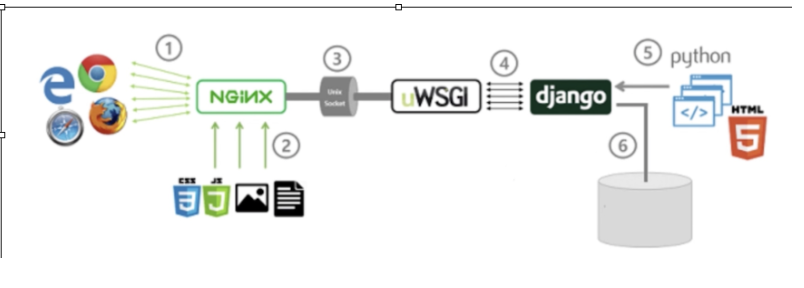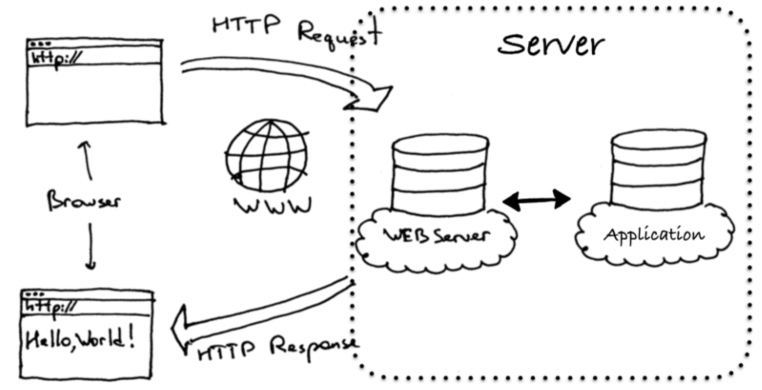nginx+uWSGI+django+virtualenv+supervisor发布web服务器
nginx+uWSGI+django+virtualenv+supervisor发布web服务器
一、导论
WSGI是Web服务器网关接口。它是一个规范,描述了Web服务器如何与Web应用程序通信,以及Web应用程序如何链接在一起以处理一个请求,(接收请求,处理请求,响应请求)
基于wsgi运行的框架有bottle,DJango,Flask,用于解析动态HTTP请求
支持WSGI的服务器
wsgiref
python自带的web服务器
Gunicorn
用于linux的 python wsgi Http服务器,常用于各种django,flask结合部署服务器。
mode_wsgi
实现了Apache与wsgi应用程序的结合
uWSGI
C语言开发,快速,自我修复,开发人员友好的WSGI服务器,用于Python Web应用程序的专业部署和开发。
在部署python程序web应用程序时,可以根据性能的需求,选择合适的wsgi server,不同的wsgi server区别在于并发支持上,有单线程,多进程,多线程,协程的区别,其功能还是近似,无非是请求路由,执行对应的函数,返回处理结果。
Django部署
Django的主要部署平台是 WSGI,这是用于Web服务器和应用程序的Python标准。
Django的 startproject管理命令设置一个简单的默认WSGI配置,可以根据需要为您的项目进行调整,并指示任何符合WSGI的应用程序服务器使用。
application
使用WSGI部署的关键概念是应用程序服务器用于与代码通信的 application 可调用。它通常在服务器可访问的Python模块中作为名为 application 的对象提供。
startproject 命令创建包含这样的 application 可调用的文件 <project_name>/wsgi.py. ,它被Django的开发服务器和生产WSGI部署使用。
WSGI服务器从其配置中获取 application 可调用的路径。 Django的内置服务器,即 runserver 命令,从 WSGI_APPLICATION 设置读取它。
1、为什么要用nginx,uwsgi
1 首先nginx 是对外的服务接口,外部浏览器通过url访问nginx,
2nginx 接收到浏览器发送过来的http请求,将包进行解析,分析url,如果是静态文件请求就直接访问用户给nginx配置的静态文件目录,直接返回用户请求的静态文件,
如果不是静态文件,而是一个动态的请求,那么nginx就将请求转发给uwsgi,uwsgi 接收到请求之后将包进行处理,处理成wsgi可以接受的格式,并发给wsgi,wsgi 根据请求调用应用程序的某个文件,某个文件的某个函数,最后处理完将返回值再次交给wsgi,wsgi将返回值进行打包,打包成uwsgi能够接收的格式,uwsgi接收wsgi 发送的请求,并转发给nginx,nginx最终将返回值返回给浏览器。
3要知道第一级的nginx并不是必须的,uwsgi完全可以完成整个的和浏览器交互的流程,但是要考虑到某些情况
1 安全问题,程序不能直接被浏览器访问到,而是通过nginx,nginx只开放某个接口,uwsgi本身是内网接口,这样运维人员在nginx上加上安全性的限制,可以达到保护程序的作用。
2负载均衡问题,一个uwsgi很可能不够用,即使开了多个work也是不行,毕竟一台机器的cpu和内存都是有限的,有了nginx做代理,一个nginx可以代理多台uwsgi完成uwsgi的负载均衡。
3静态文件问题,用django或是uwsgi这种东西来负责静态文件的处理是很浪费的行为,而且他们本身对文件的处理也不如nginx好,所以整个静态文件的处理都直接由nginx完成,静态文件的访问完全不去经过uwsgi以及其后面的东西。
2、nginx官网
http://nginx.org/en/n/3、ginx有关uwsgi模块介绍
http://nginx.org/en/docs/http/ngx_http_uwsgi_module.html
方便我们快速开发web程序,http请求的动态数据就是由web框架来提供处理的。
3、本文将nginx、WSGI、uwsgi、uWSGI、django这几个关系梳理一下。
wsgi 全称web server gateway interface,wsgi不是服务器,也不是python模块,只是一种协议,描述web server如何和web application通信的规则。
运行在wsgi上的web框架有bottle,flask,django
uwsgi 和wsgi一样是通信协议,是uWSGI服务器的单独协议,用于定义传输信息的类型
uWSGI 是一个web服务器,实现了WSGI协议,uwsgi协议。a
nginx web服务器,更加安全,更好的处理处理静态资源,缓存功能,负载均衡,因此nginx的强劲性能,配合uWSGI服务器会更加安全,性能有保障。
django 高级的python web框架,用于快速开发,解决web开发的大部分麻烦,程序员可以更专注业务逻辑,无须重新造轮子
4、逻辑


web服务器
传统的c/s架构,请求的过程是
客户端 > 服务器
服务器 > 客户端
服务器就是:1.接收请求 2.处理请求 3.返回响应
web框架层
HTTP的动态数据交给web框架,例如django遵循MTV模式处理请求。
HTTp协议使用url定位资源,urls.py将路由请求交给views视图处理,然后返回一个结果,完成一次请求。
web框架使用者只需要处理业务的逻辑即可。
如果将一次通信转化为“对话”的过程
Nginx:hello wsgi,我刚收到一个请求,你准备下然后让django来处理吧
WSGI:好的nginx,我马上设置环境变量,然后把请求交给django
Django:谢谢WSGI,我处理完请求马上给你响应结果
WSGI:好的,我在等着
Django:搞定啦,麻烦wsgi吧响应结果传递给nginx
WSGI:太棒了,nginx,响应结果请收好,已经按照要求传递给你了
nginx:好滴。我把响应交给用户。合作愉快
二、Django Nginx+uwsgi 安装配置
在前面的章节中我们使用 python manage.py runserver 来运行服务器。这只适用测试环境中使用。
正式发布的服务,需要一个可以稳定而持续的服务器。
2.1基础开发环境配置
yum groupinstall "Development tools"
yum install zlib-devel bzip2-devel pcre-devel openssl-devel ncurses-devel sqlite-devel readline-devel tk-devel
2.2提前安装好python3环境
https://www.cnblogs.com/pyyu/p/7402145.html
2.3virtualenv
请确保你的虚拟环境正常工作
https://www.cnblogs.com/pyyu/p/9015317.html
2.4安装django1.11
pip3 install django==1.11
#创建django项目mysite
django-admin startproject mysite
#创建app01
python3 manage.py startapp app01
mysite/settings.py
#settings.py设置
ALLOWED_HOSTS = ['*']
install app01
mysite/urls.py
from app01 import views
urlpatterns = [
url(r'^admin/', admin.site.urls),
url(r'^hello_django/', views.hello),
]
app01/views.py
from django.shortcuts import render,HttpResponse
# Create your views here.
def hello(request):
print('request is :',request)
return HttpResponse('django is ok ')
2.5安装uWSGI
进入虚拟环境venv,安装uwsgi
(venv) [root@slave 192.168.11.64 /opt]$pip3 install uwsgi
检查uwsgi版本
(venv) [root@slave 192.168.11.64 /opt]$uwsgi --version
2.0.17.1
#检查uwsgi python版本
uwsgi --python-version
运行简单的uWSGI
#启动一个python
uwsgi --http :8000 --wsgi-file test.py
- http :8000`: 使用http协议,端口8000
- `wsgi-file test.py`: 加载指定的文件,test.py
#test.py
def application(env, start_response):
start_response('200 OK', [('Content-Type','text/html')])
return [b"Hello World"] # python3
uWsgi热加载python程序
在启动命令后面加上参数
uwsgi --http :8088 --module mysite.wsgi --py-autoreload=1
#发布命令
command= /home/venv/bin/uwsgi --uwsgi 0.0.0.0:8000 --chdir /opt/mysite --home=/home/venv --module mysite.wsgi
#此时修改django代码,uWSGI会自动加载django程序,页面生效
运行django程序
#mysite/wsgi.py 确保找到这个文件
uwsgi --http :8000 --module mysite.wsgi
module mysite.wsgi`: 加载指定的wsgi模块
uwsgi配置文件
uwsgi支持ini、xml等多种配置方式,本文以 ini 为例, 在/etc/目录下新建uwsgi_nginx.ini,添加如下配置:
# mysite_uwsgi.ini file
[uwsgi]
# Django-related settings
# the base directory (full path)
chdir = /opt/mysite
# Django's wsgi file
module = mysite.wsgi
# the virtualenv (full path)
home = /opt/venv
# process-related settings
# master
master = true
# maximum number of worker processes
processes = 1
# the socket (use the full path to be safe
socket = 0.0.0.0:8000
# ... with appropriate permissions - may be needed
# chmod-socket = 664
# clear environment on exit
vacuum = true
2.6指定配置文件启动命令
uwsgi --ini /etc/uwsgi_nginx.ini
2.7配置nginx结合uWSGI
配置nginx.conf
worker_processes 1;
error_log logs/error.log;
pid logs/nginx.pid;
events {
worker_connections 1024;
}
http {
include mime.types;
default_type application/octet-stream;
log_format main '$remote_addr - $remote_user [$time_local] "$request" '
'$status $body_bytes_sent "$http_referer" '
'"$http_user_agent" "$http_x_forwarded_for"';
access_log logs/access.log main;
sendfile on;
keepalive_timeout 65;
#nginx反向代理uwsgi
server {
listen 80;
server_name 192.168.11.64;
location / {
#nginx自带ngx_http_uwsgi_module模块,起到nginx和uwsgi交互作用
#通过uwsgi_pass设置服务器地址和协议,讲动态请求转发给uwsgi处理
include /opt/nginx1-12/conf/uwsgi_params;
uwsgi_pass 0.0.0.0:8000;
root html;
index index.html index.htm;
}
#nginx处理静态页面资源
location /static{
alias /opt/nginx1-12/static;
}
#nginx处理媒体资源
location /media{
alias /opt/nginx1-12/media;
}
error_page 500 502 503 504 /50x.html;
location = /50x.html {
root html;
}
}
}
配置完启动nginx
三、supervisor
supervisor 是基于 python 的任务管理工具,用来自动运行各种后台任务,当然你也能直接利用 nohup 命令使任务自动后台运行,但如果要重启任务,每次都自己手动 kill 掉任务进程,这样很繁琐,而且一旦程序错误导致进程退出的话,系统也无法自动重载任务。
这里超哥要配置基于virtualenv的supervisor
由于supervisor在python3下无法使用,因此只能用python2去下载!!!!!!
#注意此时已经退出虚拟环境了!!!!!
yum install python-setuptools
easy_install supervisor
通过命令生成supervisor的配支文件
echo_supervisord_conf > /etc/supervisord.conf
然后再/etc/supervisord.conf末尾添加上如下代码!!!!!!
supervisord.conf配置文件参数解释
[program:xx]是被管理的进程配置参数,xx是进程的名称
[program:xx]
command=/opt/apache-tomcat-8.0.35/bin/catalina.sh run ; 程序启动命令
autostart=true ; 在supervisord启动的时候也自动启动
startsecs=10 ; 启动10秒后没有异常退出,就表示进程正常启动了,默认为1秒
autorestart=true ; 程序退出后自动重启,可选值:[unexpected,true,false],默认为unexpected,表示进程意外杀死后才重启
startretries=3 ; 启动失败自动重试次数,默认是3
user=tomcat ; 用哪个用户启动进程,默认是root
priority=999 ; 进程启动优先级,默认999,值小的优先启动
redirect_stderr=true ; 把stderr重定向到stdout,默认false
stdout_logfile_maxbytes=20MB ; stdout 日志文件大小,默认50MB
stdout_logfile_backups = 20 ; stdout 日志文件备份数,默认是10
; stdout 日志文件,需要注意当指定目录不存在时无法正常启动,所以需要手动创建目录(supervisord 会自动创建日志文件)
stdout_logfile=/opt/apache-tomcat-8.0.35/logs/catalina.out
stopasgroup=false ;默认为false,进程被杀死时,是否向这个进程组发送stop信号,包括子进程
killasgroup=false ;默认为false,向进程组发送kill信号,包括子进程
[program:my]
#command=/opt/venv/bin/uwsgi --ini /etc/uwsgi_nginx.ini #这里是结合virtualenv的命令 和supervisor的精髓!!!!
command= /home/venv/bin/uwsgi --uwsgi 0.0.0.0:8000 --chdir /opt/mysite --home=/home/venv --module mysite.wsgi
#--home指的是虚拟环境目录 --module找到 mysite/wsgi.py
最后启动supervisor,完成uWSGI启动django,nginx反向代理
supervisord -c /etc/supervisord.conf #启动supervisor
supervisorctl -c /etxc/supervisord.conf restart my #重启my项目
supervisorctl -c /etc/supervisord.conf [start|stop|restart] [program-name|all]
重新加载supervisor
一、添加好配置文件后
二、更新新的配置到supervisord
supervisorctl update
三、重新启动配置中的所有程序
supervisorctl reload
四、启动某个进程(program_name=你配置中写的程序名称)
supervisorctl start program_name
五、查看正在守候的进程
supervisorctl
六、停止某一进程 (program_name=你配置中写的程序名称)
pervisorctl stop program_name
七、重启某一进程 (program_name=你配置中写的程序名称)
supervisorctl restart program_name
八、停止全部进程
supervisorctl stop all
注意:显示用stop停止掉的进程,用reload或者update都不会自动重启。
四、django的静态文件与nginx配置
mysite/settings.py
STATIC_ROOT='/opt/nginx1-12/static'
STATIC_URL = '/static/'
STATICFILES_DIRS=[
os.path.join(BASE_DIR,"static"),
]
上述的参数STATIC_ROOT用在哪?
通过python3 manage.py collectstatic 收集所有你使用的静态文件保存到STATIC_ROOT!
STATIC_ROOT 文件夹 是用来将所有STATICFILES_DIRS中所有文件夹中的文件,以及各app中static中的文件都复制过来
# 把这些文件放到一起是为了用nginx等部署的时候更方便
五、配置一个Django项目
1.单机启动django项目,性能低,默认使用wsgiref模块,性能低的wsgi协议
python3 manager.py runserver 0.0.0.0:8000 > wsgiref模块中
2.高并发启动django,django是没有这个功能的,而uWSGI模块,遵循uwsgi协议,支持多进程处理django请求
uwsgi 通过他,启动你的django,而不再是python3 manager.py runserver 0.0.0.0:8000
3.公司中一般用 nginx + uwsgi + django + virtualenv + supervisord(进程管理工具)
搭建笔记:
1.确定依赖组件是否安装
yum install zlib-devel bzip2-devel pcre-devel openssl-devel ncurses-devel sqlite-devel readline-devel tk-devel
nginx 正向代理,反向代理的概念
用户阿段,去访问mycrm.com:80 ,他想直接从80端口,找到hello视图,也就是mycrm.com:80/hello
实现手段就是,阿段去访问 mycrm.com:80 这个nginx服务,并且让nginx,把hello这个请求,丢给后端的 uwsgi+django程序处理
1.基础环境准备好
yum groupinstall "Development tools"
yum install zlib-devel bzip2-devel pcre-devel openssl-devel ncurses-devel sqlite-devel readline-devel tk-devel
2.准备好python3环境
3.准备好virtualenv
4.安装uWSGI
1.激活虚拟环境
source /opt/all_venv/venv2/bin/activate
2.安装uWSGI
(venv2) [root@s13linux ~ 05:18:21]$pip3 install uwsgi
3.检查uwsgi版本
(venv) [root@slave 192.168.11.64 /opt]$uwsgi --version
2.0.17.1
#检查uwsgi python版本
uwsgi --python-version
4.运行一个简单的uwsgi服务器
1.创建一个test.py文件,写入内容
def application(env, start_response):
start_response('200 OK', [('Content-Type','text/html')])
return [b"Hello World"] # python3
2.然后用uwsgi命令启动
uwsgi --http :8000 --wsgi-file test.py
参数解释
http :8000: 使用http协议,端口8000
wsgi-file test.py: 加载指定的文件,test.py
5.用uwsgi运行你的django项目(测试使用)
1.准备好mysite,自己写好MTV视图函数 /hello
先确保你在项目文件夹下,例如/opt/mysite/底下
uwsgi --http :8088 --module mysite.wsgi --py-autoreload=1
参数解析
--http 启动在8088端口,--module 指定项目文件夹路径 --py-autoreload是热加载程序
6.配置nginx反向代理uwsgi+django!!!!(此步重要!!!)
1.首先kill杀掉nginx进程
2.配置nginx.conf,通过此步才能生效!!
填入重要两个参数,根据自己目录结构配置,uwsgi_pass通过这个参数,nginx才能转发请求给后端0.0.0.0:9000的应用
include /opt/nginx112/conf/uwsgi_params;
uwsgi_pass 0.0.0.0:9000;
--------------------------分割线--------------------------------------------------------
server {
listen 80;
server_name mycrm.com;
location / {
include /opt/nginx112/conf/uwsgi_params;
uwsgi_pass 0.0.0.0:9000;
root html;
index index.html index.htm;
#deny 10.0.0.1;
}
配置nginx.conf之后,启动nginx服务,等待配置启动uwsgi+django
7.配置supervisor进程管理工具
1.通过python2的包管理工具easy_install安装
yum install python-setuptools
easy_install supervisor
2.通过命令生成supervisor的配支文件
echo_supervisord_conf > /etc/supervisord.conf
3.写入/etc/supervisord.conf配置信息(参数根据自己环境填写)
[program:my_crm]
command=/opt/all_venv/venv2/bin/uwsgi --uwsgi 0.0.0.0:9000 --chdir=/opt/s13crm --home=/opt/all_venv/venv2/ --module=s13crm.wsgi
directory=/opt/s13crm
startsecs=0
stopwaitsecs=0
autostart=true
autorestart=true
8.启动supervi服务,(同时启动uwsgi+django服务)
最后启动supervisor,完成uWSGI启动django,nginx反向代理
supervisord -c /etc/supervisord.conf #启动supervisor
supervisorctl -c /etxc/supervisord.conf restart my #重启my项目
supervisorctl -c /etc/supervisord.conf [start|stop|restart] [program-name|all]
9.此时访问网站mycrm.com ,查看是否可以通过80端口,访问到django应用,完成项目发布。
由于nginx的高并发性能,配合uwsgi的多进程性能,可以达到一个线上的django应用发布!!!
参考文档:http://uwsgi-docs-zh.readthedocs.io/zh_CN/latest/tutorials/Django_and_nginx.html
uwsgi热加载:https://uwsgi-docs-zh.readthedocs.io/zh_CN/latest/Management.html

